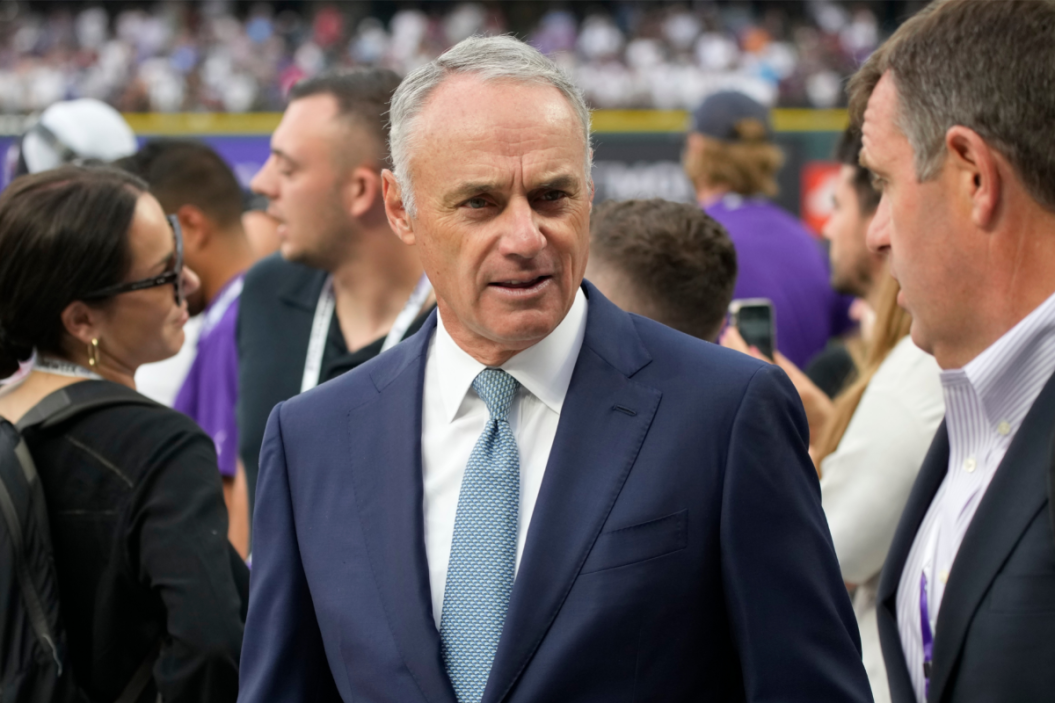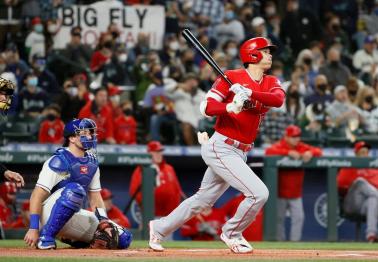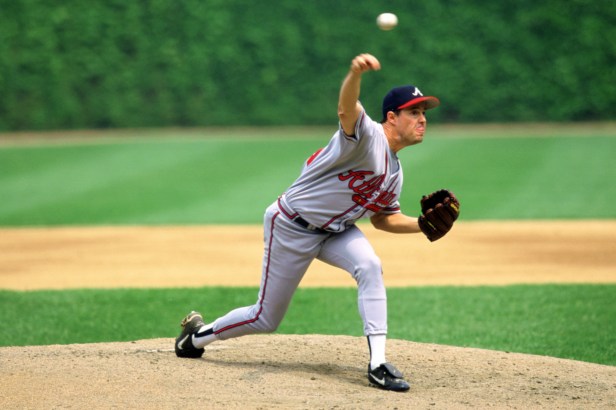There is no joy in Mudville. There is no Phillie Phanatic in the stands, no Shohei Ohtani on the mound and no Bat Boys wearing out a sunflower-seeded pathway from the dugout to home plate. The lights on Fenway Park, Wrigley Field, Dodger Stadium and Coors Field remain dim, just like the fate of this year's season.
The 2022 MLB Season will not start on time, as the MLB Players Association and MLB's ownership (led by MLB Commissioner Rob Manfred) continue to butt heads over a new Collective Bargaining Agreement. In the past CBA negotiations, we've seen both sides attempt to start the season on time, but this time around, things feel different.
The battle between the MLBPA and Major League Baseball's Owners has raged for decades, each time halting the game for an extended period of time while a new CBA is hashed out. The agreement, negotiated by both sides, sets forth a set of rules and practices an agreed-upon length of time, usually around seven or eight seasons. These negotiations are often contentious, as each side refuses to budge on key issues or reconcile on past initiatives that have failed to benefit both sides equally.
In 2021, the MLB owners announced they would be shutting down operations, beginning a lockout that is likely to delay the beginning of the 2022 season. Fans clamoring for Opening Day may need to temper their expectations, as both sides hammer out a deal. As the league begins to cancel Spring Training games and fan morale begins to dip, we thought this would be a great time to talk about MLB work stoppages both past and present. If there's no baseball to discuss, we might as well talk about the current events in the game, right?
The Difference Between a Lockout and a Strike
This is a sad day for baseball.
— Jeff Passan (@JeffPassan) March 1, 2022
Maybe the most important piece of this conversation is the difference between what's going on now versus other league stoppages in the past.
The most memorable labor disagreement came in 1994, when the players, under the direction of the players union, went on strike. The season had begun without an agreement between both sides, and the players had hoped team owners would remove their proposed salary cap from the agreement. In the middle of the season, the owners presented a new offer, with the salary cap still intact, and the players walked off the field. Including the postseason, over 900 games would be lost during the 1994-95 strike, and the game would take years to recover its favor with fans.
The 1994-95 strike is different than what's going on ahead of the 2022 season, for several reasons. In this case, after both sides met to discuss a new CBA, MLB and the team owners decided to lock out the players, halting baseball operations completely. Rather than the players walking off the field, this time around it's the owners turning off the lights and locking the door. That's why 2022's labor dispute is a lockout and not a strike. And it's not the first time a lockout has been initiated in the league's history.
In 2022, MLB's owners have shut out the players from negotiating contracts for the upcoming season, as well as stopping players from using the team facilities to work out and get ready for the upcoming season. By initiating a lockout, MLB ownership is applying pressure to the union to give in on some concessions in order to allow players back into facilities and to restart the free agent market.
Why MLB is in a Lockout
Currently, MLB All-Stars like Clayton Kershaw, Carlos Correa and Freddie Freeman are still without contracts for the upcoming season. The only way current free agents can negotiate new contracts is after the lockout ends. Normally the offseason is spent with fans zeroed in on their Twitter feeds waiting for ESPN's Jeff Passan to announce the latest deal. Instead, Passan has taken to tweeting financial documents and meeting durations.
And with that comes a different view of the spin being placed on the outcomes, or lack thereof, within the ongoing discussions. The players, who have been represented by New York Mets' Max Scherzer and Francisco Lindor, amongst others, are fighting for stronger protections for prospects who may be dealing with service time manipulation, higher minimum salaries, an end to tanking, and for better working conditions for minor league players, to name a few of their sticking points.
Teams like the Baltimore Orioles have sold off their valuable assets and have been in the basement of the American League East for the last few seasons, all the while spending $100 million less than the average MLB payroll.
The MLB Owners' biggest desire is an expanded postseason, similar to the one we saw in 2020 after the COVID-shortened season. The reason for this is that the MLB owners get 100 percent of the TV revenue from postseason games, and expanding the number of teams playing in October means more money to go around. The players have argued that with an expanded playoffs salaries would be driven down by teams unwilling to pay more for better players since more teams will qualify for the postseason.
How Negotiations Have Gone Since
Since MLB ownership initiated the lockout in December of 2021, talks between both sides have not gone well. At one point, similarly to how things went in 1994, MLB called for a federal mediator to step in and help broker a joint agreement. This move was denied by the MLBPA, who saw this as a bad faith tactic from the owners, remarking that the other side had yet to respond with a counter-proposal at that time.
Other issues have seen both sides coming closer together, albeit slowly. The players have looked to use a draft lottery system as a way to dissuade teams from tanking. The NBA runs a similar system in which the top seven picks are determined via a lottery system. The players' proposed system would work similarly, and the rest of the draft order would then be determined through a number of factors including a team's relation to revenue sharing.
In a recent proposal, owners agreed to the lottery system but tied their acceptance to their desire for an expanded postseason. The players saw this as a non-starter and rejected the proposal, but it's promising to see some positive momentum even without concrete progress.
The current 2021-22 MLB Lockout will now require the first weeks of the season to be canceled as neither side seems poised to relent. As of publication, Major League Baseball is currently in a lockout, and both sides still feel far apart on several issues. Yes, talks are still ongoing, but anyone who has been working from home can tell you that not a ton gets done in meetings that last 15 to 20 minutes.
Even if both sides were to magically come to a mutually beneficial agreement, it's not as if baseball can begin immediately. The loss of Spring Training, where players and teams both workout their offseason rust and solidify rosters, is felt and still needs to occur. The longer both sides wait, the longer the wait for Opening Day, and the larger the number of regular season games lost.
How Many Labor Disputes Have Stopped Baseball Seasons?
Related: The 18 Best MLB Uniforms That Don't Exist Anymore (But Really Should)
In the history of America's Pastime, baseball has stopped play due to labor negotiations a total of nine times, including the most recent MLB lockout.
That's right, this is not the first time a lockout has been initiated in the league's history. The first strike came in 1972 when players refused to play the first week and a half of games due to issues they had with their pensions and salary arbitration. MLB ownership quickly jumped to solve the dispute, and a total of 86 games were lost across the league.
The following season, the first lockout took place, with owners looking to create a more clearly defined arbitration process in the new CBA. No games were lost, however, as the lockout took place in February, slightly delaying spring training activities across the league. In fact, the next two work stoppages, another lockout in 1976 over the reserve clause and a lockout in 1990 over free agency and salary minimums, saw no games affected. However, the most damaging work stoppage was still on the horizon.
The 1990 lockout, which came three years after the NFL's infamous 1987 lockout, also came on the heels of a devastating era of collusion between MLB owners, who attempted to sink the free agency market. When Hall of Fame catcher Carlton Fisk went on the free agent market, he was expecting a big deal. No team offered him a contract, except the Chicago White Sox, the team he had just left. The 1990 lockout was contentious, as both sides had a bone to pick with the other.
The players' strike in the middle of the 1994 regular season sent shockwaves across the game and is still very much felt today. The MLB Owners put forth a plan that included a salary cap, intending to give smaller ball clubs a chance to compete with larger market teams. The players were adamant that this was not in their best interests, and the union saw the plan as a way for the owners to keep more money flowing to themselves, rather than the players. So the players walked away midseason, in the hopes that a labor deal could be struck before the season ended.
Over the next eight months, MLB players were faced with enormous scrutiny as the media and ownership painted them as greedy millionaires. The damage done to the game would be lasting, with some franchises never recovering from the games lost during the strike. The Montreal Expos were 74-40 when the strike began, halting what could have been their first World Series appearance in franchise history. Ten years later, MLB would move the team out of Montreal, citing poor attendance and greener pastures in Washington, DC.
To say that each work stoppage is an insular event would be misguided. For example, one of the main issues in the current MLB Lockout is the competitive balance tax (CBT, for short) which was implemented in 1997 in response to the 1994-95 strike. The CBT, more colloquially known as the luxury tax, allows MLB teams to work within a structure similar to their proposed salary cap, without actually implementing one. If a team, like the free-spending Yankees or Red Sox, goes over the predetermined luxury tax, the CBT would be collected and dispersed amongst the teams who fell below the tax threshold.
It's easy to see why the CBT is so important to owners, and so opposed by players. The salary cap debate has been raging for almost 25 years now, and the same arguments for and against its implementation are being heard today by both sides at Roger Dean Stadium in Jupiter, Fla.
The Effect of MLB's Lockout
Fans chanting: 'We want baseball'
— Bob Nightengale (@BNightengale) March 1, 2022
After a COVID-19 pandemic shortened season in 2020, from a fan's perspective, it's beginning to feel like we're losing out on seeing generational talent in their prime. As it was in 1994, the real victims of the work stoppage are the fans who love this game more than anything. To some, Opening Day is a national holiday, the first sign of spring, and even, the beginning of their favorite season: baseball season.
Memories of first trips to the ballpark are lost, fans will move on to other sports, and even give up the game entirely. In a world where baseball is losing its grip on the younger generation of fans, a brutal works stoppage, instigated by either side, is damaging to the game's future.
For what it's worth, this writer feels that the players have been forthright in their negotiations, and their proposals have been solid. If there's one side that is stonewalling and stopping progress, and by extension preventing the 2022 MLB season from the beginning: it's MLB and its ownership.
Let's hope that this doesn't get out of hand and that we'll hear the words "Play Ball!" sooner rather than later. After last season's thrilling action on the diamond, fans are ready to root, root, root for their home team. Hopefully, they'll be able to in 2022.



